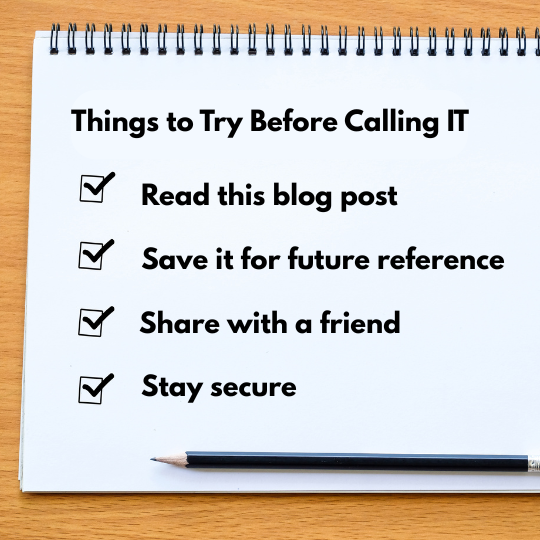

Before you call IT, try these 10 easy steps. They’re written for people who feel frustrated with technology and want clear, gentle instructions. Do only the steps that feel comfortable — and if none of them help, call IT and tell them which steps you already tried (that helps a lot).
Try one step at a time. Don’t press lots of buttons.
If something shows an error message, take a photo of the screen and save it. That helps IT.
Want a printable checklist? Download the one-page checklist below and keep it by your computer.
Write down what happened — One short sentence that says what you clicked, what you expected, and what went wrong. Example: “Clicked email → white screen → nothing loads.”
Turn it off, wait 10 seconds, then turn it back on — Power cycle your device. This fixes many problems.
Check the power and cables — Make sure cords are plugged in and not loose.
Look at the Wi-Fi — Try another device to see if the internet is down. Restart the router if needed.
Check your password & Caps Lock — Make sure Caps Lock isn’t on and re-type the password slowly.
Close and reopen the program or tab — If an app is frozen, close it fully and reopen it.
Try another browser or device — If a website won’t load in one browser, try another or your phone.
Take a clear photo of the error or screen — A photo is often faster than typing an explanation.
Check the time and date on your device — If the clock is wrong, websites and logins can fail.
Tell IT what you already tried — List the steps you took when you call or email IT.
Why it helps: A single sentence saves time — IT can start troubleshooting faster.
How to do it: On a notepad or your phone, write one short line: what you clicked, what you expected, and what happened instead. Add the time and the device you were using (phone, laptop). Example: “Clicked calendar app → app froze → 9:02 AM → laptop.”
Why it helps: Restarting clears temporary glitches.
How to do it:
Windows PC: Click Start → Power → Restart.
Mac: Click the Apple menu () → Restart.
Phone/Tablet: Hold the power button and follow the on-screen option to power off, wait ~10 seconds, then turn it on again.
Why it helps: Loose power or data cables are surprisingly common.
How to do it: Look behind your computer or router. If a cord looks loose, push it gently but firmly until it clicks. If a power strip is switched off, flip it on. Don’t force anything — if a plug won’t go in, ask someone for help.
Why it helps: If the internet is down, many things won’t work.
How to do it: Try loading a website on another device (phone/tablet). If that device also won’t load pages, your internet is likely down. To restart your router: unplug it, wait 10 seconds, then plug it back in. Wait a minute for it to reconnect.
Why it helps: Typing mistakes and Caps Lock cause many login issues.
How to do it: If a password won’t work, check if Caps Lock is on. Retype the password slowly. If it still fails, use the “Forgot password” link if available — but tell IT if you use that so they know what happened.
Why it helps: Apps sometimes freeze. Restarting the program often fixes it.
How to do it: Close the window, or swipe the app away on your phone, then open it again. If the app still won’t open, move to the next step.
Why it helps: The issue might be specific to one browser or device.
How to do it: If you’re on Chrome, try Safari or Edge. Or open the same website on your phone. If it works elsewhere, note which device failed and tell IT.
Why it helps: A photo shows the exact message and saves time.
How to do it: Use your phone camera and hold steady. Make sure the text is readable. Attach the photo to your email or show it to IT when you call.
Why it helps: An incorrect clock can cause websites and logins to fail.
How to do it: Click the clock on your computer or go to Settings → Date & Time and make sure it’s correct. If it’s wrong, update it or toggle “Set time automatically.”
Why it helps: IT will avoid repeating steps and can get to the real problem sooner.
How to do it: When you call or email, list the steps you tried, the device you used, and attach any photos or notes you made.
Grab the one-page checklist PDF below to keep by your computer. It’s large-font, easy to read, and has checkboxes for each step so older adults can tick them off.
[Download the one-page checklist PDF — Before You Call IT] (attach your PDF file or link here)